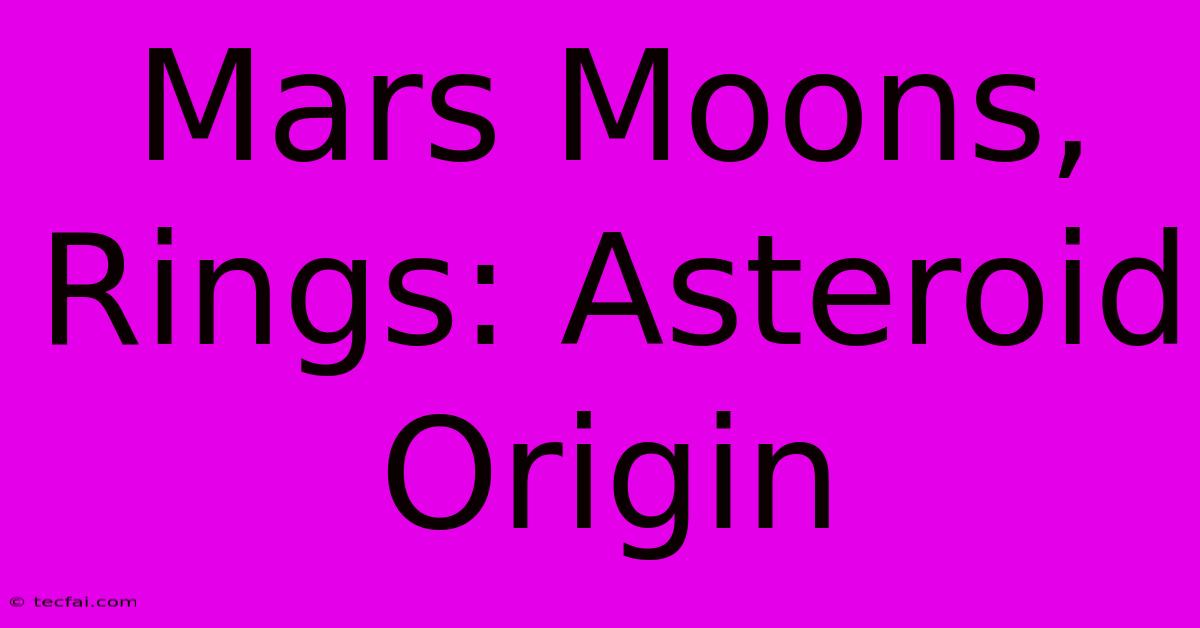Mars Moons, Rings: Asteroid Origin

Discover more detailed and exciting information on our website. Click the link below to start your adventure: Visit Best Website tecfai.com. Don't miss out!
Table of Contents
Mars Moons, Rings: An Asteroid Origin Story
Mars, the rusty red planet, boasts a fascinating pair of moons, Phobos and Deimos, that have long captivated scientists. Unlike Earth's single, large moon, these Martian satellites are small, irregularly shaped, and bear a striking resemblance to asteroids. This similarity has fueled a compelling theory: that Phobos and Deimos are captured asteroids. But the story is far more complex than a simple capture event, hinting at a dynamic early solar system and potentially even a lost Martian ring system.
The Case for Captured Asteroids
The most widely accepted hypothesis proposes that Phobos and Deimos originated in the asteroid belt, a region between Mars and Jupiter teeming with rocky remnants from the solar system's formation. Their dark, carbonaceous composition aligns with many asteroids found in the outer asteroid belt. Their irregular shapes, unlike the spherical moons formed alongside their planets, further support the captured asteroid theory. These bodies weren't born alongside Mars but rather were gravitationally snared later in the planet's history.
The Mechanics of Capture: A Delicate Dance
Capturing an asteroid isn't a simple event. It requires a precise interplay of gravitational forces. A direct collision is highly unlikely; the asteroid needs to be slowed down significantly to be trapped within Mars' gravitational pull. This slowing typically occurs through interactions with other celestial bodies, or perhaps through atmospheric drag if Mars had a more substantial atmosphere in the past. This intricate process significantly limits the chances of successful capture, making the presence of Phobos and Deimos all the more intriguing.
Phobos: A Closer Look and a Future Collision
Phobos, the larger of the two moons, is particularly intriguing. Its orbit is unusually close to Mars, completing a revolution in just seven hours. This proximity results in significant tidal forces from Mars, slowly pulling Phobos closer. Scientists predict that within the next 50 million years, Phobos will either crash into Mars or break apart, potentially forming a ring system around the planet.
Deimos: The More Distant Companion
Deimos, smaller and more distant than Phobos, presents a slightly less dramatic story. Its orbit is more stable and less susceptible to the intense tidal forces affecting Phobos. It continues its quiet orbit, offering a valuable window into the past, providing clues to the early solar system's chaotic dynamics.
The Phantom Martian Ring: A Possible Past
The potential fate of Phobos leads to a fascinating speculation: the existence of a past Martian ring system. If Phobos does indeed break apart, it will create a temporary ring. But could previous capture events, or the collisional debris of a larger Martian moon, have created rings in the distant past? This remains a topic of ongoing research and debate, with computer simulations attempting to model potential ring formation and dissipation scenarios.
Ongoing Research and Future Missions
Scientists continue to study Phobos and Deimos, using both ground-based telescopes and orbiting spacecraft. Future missions aim to conduct more detailed surface analyses, potentially returning samples to Earth. These endeavors are crucial to refining our understanding of the moons’ composition, origin, and the implications for our broader comprehension of planetary formation and evolution. Unraveling the secrets of Mars' moons is key to understanding the dynamic and often violent history of our solar system. The ongoing research holds the promise of revealing a captivating story involving gravitational capture, tidal forces, and potentially, the shimmering spectacle of a lost Martian ring system.

Thank you for visiting our website wich cover about Mars Moons, Rings: Asteroid Origin. We hope the information provided has been useful to you. Feel free to contact us if you have any questions or need further assistance. See you next time and dont miss to bookmark.
Featured Posts
-
Canada Post Union Reach Limited Progress On Strike
Nov 26, 2024
-
Malapit Na Panalo Nawala Sa Kings
Nov 26, 2024
-
Nag Akyat Ang Chill Guy Coin Laban Ng Creator
Nov 26, 2024
-
Harbaughs Ravens Defeat Chargers 3 0 Against Them
Nov 26, 2024
-
Ronaldos Double Leads Al Nassr To Acl Victory
Nov 26, 2024
